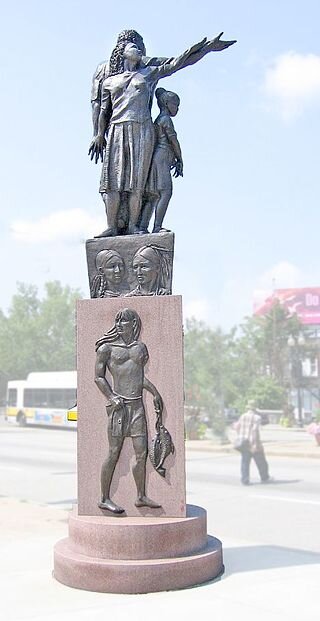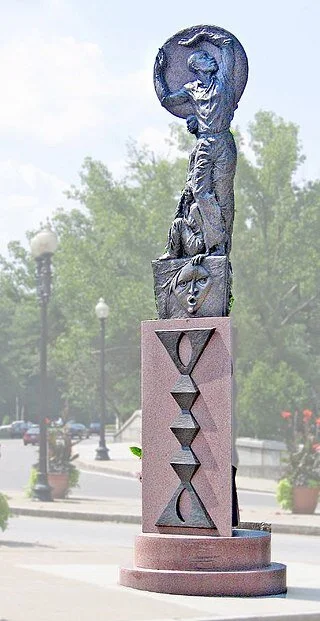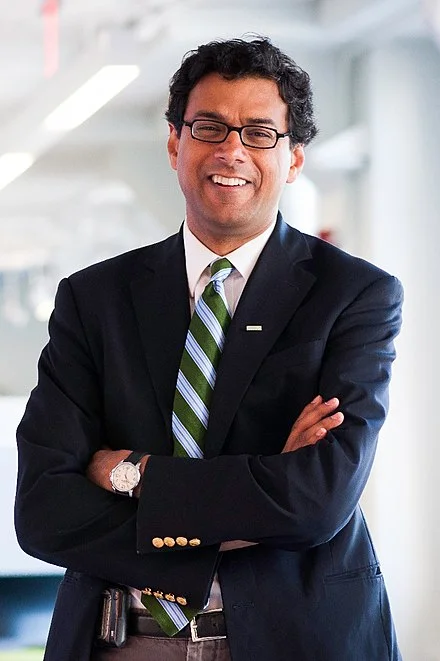
Chase opens first ‘community center’ in New England
"Rise," a pair of statues installed in 2005, flank Blue Hill Avenue in Mattapan and define it as a gateway to Boston. The statue above is by Fern Cunningham. The one below is by Karen Eutemy.
Jon Chesto, of The Boston Globe, reports:
“Chase has opened the doors to its first ‘Community Center,’ in New England, in Mattapan Square. The retail arm of JPMorgan Chase & Co. is planning these community centers in 16 urban neighborhoods across the country, with 10 such centers opening so far. They provide traditional branch banking services, along with other community services. In the case of the Mattapan branch, Chase regional director Roxann Cooke said Chase has reached out to local nonprofits to help offer financial seminars and workshops at the branch for nearby residents and small-business owners.’’
Chase targets N.E. college students
Temporary headquarters of JPMorgan Chase, at 383 Madison Ave. in Manhattan
From The New England Council (newenglandcouncil.com)
“JPMorgan Chase & Co. plans to open dozens of retail branch locations around New England starting this year and into 2020. Chase (as it’s generally called) is the nation’s largest bank.
“Chase is optimistic about its growth plan for New England and is particularly interested in accessing the large student population in the region. At the end of September, the bank opened its first new retail location on Brown University’s campus, in Providence. In addition to 60 retail branches, Chase will also install over 130 ATM’s in the region. Chase, which currently employs more than 1,500 people in New England, plans to hire over 350 people through this regional expansion. The next New England branch to open will be in Dedham, Mass., in mid-December.’’
Executive challenge
Atul Gawande, M.D.
From Robert Whitcomb's "Digital Diary,'' in GoLocal24.com
Atul Gawande, M.D., is a fine surgeon, writer, charming public speaker and teacher who became famous writing about the extreme inequities of health-care provision and cost in America. His main statistical tools were developed by the Dartmouth (College) Institute for Health Policy and Clinical Practice.
Now he has been tapped to be CEO of a still somewhat mysterious health-care venture formed by the far-too-big Amazon, giant conglomerate Berkshire Hathaway and JPMorgan, the behemoth bank. The companies haven’t yet presented a specific plan for the new nonprofit enterprise, which hasn’t even been named yet. But the main mission is to cut health-care costs for employers.
The good economic news for New England is that this outfit, which I suppose could become very big itself, will be based in Boston.
"I have devoted my public health career to building scalable solutions for better healthcare delivery that are saving lives, reducing suffering, and eliminating wasteful spending both in the U.S. and across the world. Now I have the backing of these remarkable organizations to pursue this mission with even greater impact for more than a million people {who work for the three companies}, and in doing so incubate better models of care for all. This work will take time but must be done. The system is broken, and better is possible," Gawande said.
The system is indeed broken, but can this rock star run a very large organization?
James P. Freeman: Past time to break up America's mega-banks before they cause another crash
JPMorgan Chase & Co. headquarters, in Manhattan.
As Americans were lounging comfortably over the 4th of July holiday, some were surely feeling a sense of new-found serenity. Not because they were full of burgers, barkers and beer. On the contrary, they were digesting the news that 34 of the nation’s largest banks, for the first time since the financial crisis began a decade ago, all passed the Federal Reserve’s annual “stress tests,” which, according to The Wall Street Journal, “could bolster the industry’s case for cutting back regulation.” But hold the match before lighting leftover fireworks in celebration. Break up the banks first.
Remarkably, the five largest banks today — JPMorgan Chase & Co. Bank of America, Citibank, Wells Fargo Bank, US Bank — now control about 45 percent of the financial industry’s total assets or roughly $7.3 trillion in assets. To put that number in perspective, the size of the U.S. economy is roughly $18 billion.
Twenty-five years ago, the five largest banks owned just 10 percent of all financial assets. The Federal Deposit Insurance Corporation’s statistics reveal that in 1992 there were 11,463 commercial banks and 2,390 savings and loans. By March of 2017, that number had dwindled to 5,060 commercial banks and just 796 savings institutions. The assets held by the five largest banks in 2007 – $4.6 trillion – increased by more than 150 percent over the past decade, when they held 35 percent of industry assets.
The sharp rise in the concentration of these assets (a measure of size and wealth) has real economic, political and social ramifications. As oxfamamerica.org fears, “These massive banks use their wealth to wield significant political and economic power in the U.S., in the countries where they operate, and in the international arena.” Finance today, author Rana Foroohar reasons in Makers and Takers, “holds a disproportionate amount of power in sheer economic terms.” (It takes about 25 percent of all corporate profits while creating only 4 percent of all jobs.)
Moreover, writing five years ago in The Washington Post, just as the banking system was being recalibrated and reregulated, U.S. Sen. Sherrod Brown, D-Ohio, ranking member of the Senate Banking Committee, recognized then (and still true today) what the federal government should recognize now: “Even at the best-managed firms, there are dangerous consequences of large, complex institutions undertaking large, complex activities. These companies are simply too big to manage, and they’re still too big to fail.” While Brown is correct in citing “Too Big To Fail” (a warped public policy), he is right to emphasize (as many more public officials should) that these firms are simply too big to manage and maintain.
JPMorgan Chase is a financial colossus. In January 2017, it reported assets of $2.5 trillion that generated $99 billion in revenue and earned $24.7 billion in profit. It is the largest U.S.-domiciled bank and the sixth largest bank in the world. Today, it alone holds over 12 percent of the industry’s total assets, a greater share than the five biggest banks put together in 1992. Its global workforce of 240,000 operates in 60 countries. From 2009 to 2015, the bank paid $38 billion in fines and settlements (involving among them the Bernie Madoff and London Whale scandals), mere rounding errors in its ethics and financials.
Jamie Dimon is the company's chairman and chief executive officer, perhaps the second most difficult job in the country, only after the presidency of the United States. To say that he “manages” the firm would be an overstatement. More accurately, he “presides.” Dimon was named CEO in 2005 (when assets were only $1.2 trillion) and is widely given credit for adroitly navigating the financial turmoil of 2008-2009. In 2015, he made $27 million and said that banks were “under assault” by regulators. He keeps two lists in his breast pocket: what he owes people; what people owe him.
Now 61, he is the subject of much discussion centering on speculation about who his successor will be. In an interview for Bloomberg Television last September, Dimon said he would leave “when the right person is ready.” But who is ever “ready” and able to run a $2.5 trillion company? No one competently.
Wells Fargo ($2 trillion in assets with 8,500 locations) was thought to be among the best managed banks before, during, and after the crisis until it was revealed last year that it had fired 5,300 employees and clawed back $180 million in compensation, due to the unauthorized opening of 2 million customer accounts. A flawed “decentralized structure” and perverse sales culture were to blame for illicit activities that occurred over a decade.
Fortune Magazine in March 2007, with sterling irony, named Lehman Brothers (No. 1) and Bear Stearns (No. 2), respectively, as the most admired companies in the securities industry. By the end of 2008 Lehman Brothers had filed for bankruptcy (the largest in U.S. history, $692 billion) and Bear Stearns had been sold in a fire sale by fiat to JPMorgan Chase.
Big banks are driven by avarice and algorithms (complicated code-directing computers to effect financial transactions by the millisecond), not altruism. Lending is secondary to speculating. Complexity has replaced familiarity. Vaults hold more data than gold. And traders can destroy banks faster than boards of directors. On any given business day, no executive or regulator can be certain of the health of these institutions.
This is the new Wall Street alchemy.
The first public signs of distress in the financial system before the Crash of 2008 appeared 10 years ago, when a July 2007 letter to the firm’s investors disclosed that two obscure hedge funds managed by Bear Stearns had collapsed. The long fuse had been lit. The Great Recession was triggered. And the torch paper was provided in the form of legislation.
The Financial Services Modernization Act of 1999 (known as Gramm-Leach-Bliley) neutered the Banking Act of 1933 (known as Glass-Steagall), which separated the riskier elements of investment banking from the more conservative aspects of commercial banking. The 1999 law spurred a new model of financial supermarkets (banking, investments and insurance under one company). It also unwittingly fostered a new risk-taking model: Losses could be socialized (depositors, shareholders, taxpayers) while profits could be privatized (executive compensation). Exotic financial instruments and ineffective regulatory oversight fueled the meltdown.
Today’s big banks largely resemble Zuzu’s petals in the film It’s a Wonderful Life, seemingly mended but not made better. During the Crash/Panic of 2008, the federal government engineered the financial equivalent of pasting damaged rose petals in a desperate attempt to prevent the total collapse of the banking sector. It effectively merged the unwieldy likes of Merrill Lynch with Bank of America, Bear Stearns with JP Morgan and Wachovia with Wells Fargo.
In the wake of the crisis (which ultimately required $1.59 trillion in government bailouts and another $12 trillion in guarantees and loans), The Dodd-Frank Wall Street Reform and Consumer Protection Act of 2010 became law. It sought to make the financial system safer and fairer than it had been, to reduce the risk of financial crises, to protect the economy from this kind of devastating costs of risky behavior, and to provide a process for the orderly disposition of failing firms. But after a staggering 848 pages and 8,843 new rules and regulations, Dodd-Frank does nothing to reduce the size of, and hence the systemic risk posed by, the biggest banks.
“We may have gotten past the crisis of 2008,” Foroohar concludes in her book, but, disturbingly, “we have not fixed our financial system.” Bankers still “exert immense soft power” via the revolving door between Washington and Wall Street. And today’s top government regulators are littered with former banking executives, who are “disinclined to police the industry.”
The idea of overhauling big banks, however, is attracting some surprising converts.
In May, President Trump acknowledged that he was “looking at” breaking up the big banks. And the principal architects and former co-heads of the first financial supermarket — Citigroup — have had an epiphany of sorts. In 2015, ex-Citicorp CEO John Reed wrote in the Financial Times that “the universal banking model is inherently unstable and unworkable. No amount of restructuring, management change or regulation is ever likely to change that.” And in 2012, Sandy Weill, another former Citicorp CEO, called for a return to Glass-Steagall.
Dodd-Frank mandates that the Federal Reserve conduct annual stress tests on financial institutions with assets over $50 billion. This year’s test on 34 banks relied upon enhanced computer modeling to assess how those banks would perform under “adverse and severely adverse” economic conditions. But such modeling is an unreliable predictor of reality. As JPMorgan Chase knows well.
In May 2012, The New York Times provided insights into massive trading losses at JP Morgan Chase. The bank had little idea that the losses were brewing. It entrusted computer modeling pioneered by its bankers in the 1990s to identify and measure potential losses. But the bank tripped up its measurements. It deployed a new model that underestimated losses; when it redeployed the old model, it nearly doubled the losses. As The Times chillingly remembers, such computer programs “proved useless during the financial crisis.”
James P. Freeman, a former banker, is a New England-based writer, former columnist with The Cape Cod Times and frequent contributor to New England Diary. This piece first ran in The New Boston Post.






